Understanding the Cost of a 10 Carat Diamond
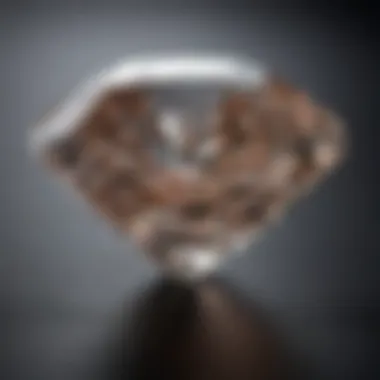
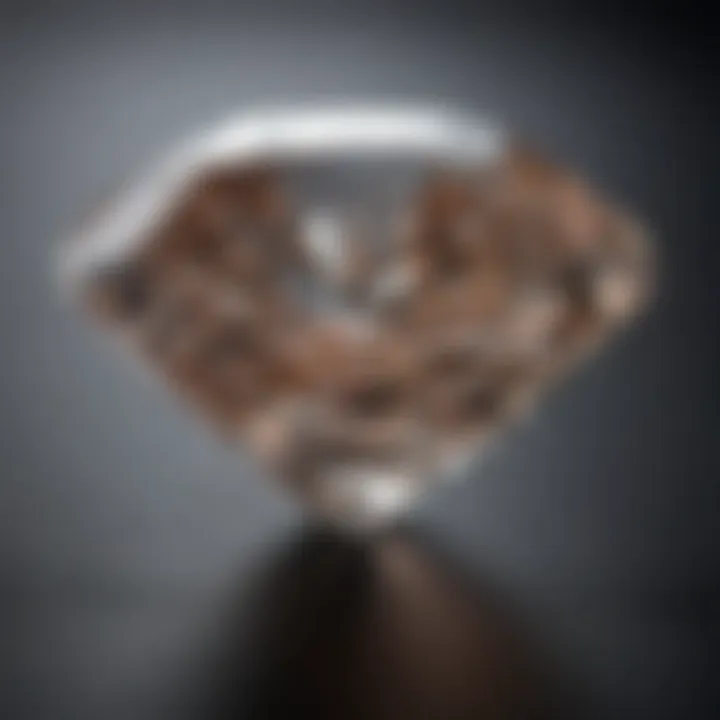
Gemstone Overview
Diamonds have captured the imagination of enthusiasts and collectors for centuries, not merely as symbols of wealth but as marvels of nature. At the heart of this allure lies a conversation surrounding certain diamonds, particularly those of considerable size, such as a 10 carat diamond. These stones are not just precious; they are substantial in both physical size and economic value.
Definition and Origins
A diamond is defined as a solid form of carbon that has been subjected to intense conditions of heat and pressure deep within the Earth’s mantle. It can range from the smallest of chips that fit on the tip of a pencil to massive, breathtaking stones that make collectors and jewelers alike swoon. The 10 carat diamonds represent a weight milestone in the world of gemstones, where every carat significantly amplifies both allure and cost.
The journey of diamonds, especially those weighing around 10 carats, often initiates far beyond the ordinary. Countries like South Africa, Russia, and Canada are known for their rich deposits of diamonds, although smaller, albeit precious, finds happen around the globe. These geological environments are what give rise to extraordinary gems, each with its own narrative entwined in the Earth’s history.
Historical Significance
Throughout history, diamonds have been adorned on crowns and cherished in royal regalia, serving as tokens of power and elegance. From the famed Hope Diamond, with its rich backstory of misfortune, to the Koh-i-Noor, which continuously circles the narrative of conquest and power, the historical standpoint surrounding large diamonds is as colorful as the stones themselves. In many cultures, diamonds are viewed as symbols of eternal love, making them a natural choice for engagement rings and presents on significant anniversaries.
Gemstone Properties
Understanding a diamond's properties is pivotal when delving into its evaluation and significance. Not all diamonds are created equal, and this couplet of characteristics will play into the cost analysis of larger examples like the 10 carat varieties.
Hardness and Durability
Diamonds stand alone at the top of the Mohs scale with a perfect rating of 10, making them the hardest known natural material. This hardness speaks volumes not only about their durability but also about their long-lasting brilliance. While they can chip or scratch under extreme conditions, daily wear means that a diamond, especially one of significant size, remains almost untouchable by wear and tear.
Color and Clarity
When assessing a 10 carat diamond, color and clarity are paramount criteria to consider. Diamonds come in various colors, ranging from pure white to shades of yellow, brown, and even rare hues like blue or pink. The most sought-after diamonds display minimal color, appearing completely clear. Clarity refers to the absence of inclusions or blemishes within the stone. For larger stones, these aspects become even more crucial, as any imperfection can greatly diminish its value.
"A diamond's worth is more than just its carat; it lies in its brilliance and clarity that capture the light and the heart."
A 10 carat diamond, if clear and near-colorless, commands a premium in the marketplace, highlighting the need for understanding characteristics like cut, which dictates how a diamond interacts with light, adding another layer to its allure.
Each element discussed reflects part of the bigger picture when analyzing costs. In the upcoming sections, we will delve deeper into the nuances of diamond grading criteria, market trends, and the craftsmanship that distinguishes fine diamonds from the rest.
Understanding Diamond Weight and Size
When it comes to diamonds, weight and size often take center stage in discussions surrounding their value. Understanding how these factors influence the appeal of a diamond is crucial, especially for those investing significant sums into these stones. In this section, we aim to clarify why comprehending the weight and size of a diamond is essential not only for making informed purchase decisions but also for enhancing one's appreciation of these magnificent gems.
The Significance of Carat Weight
Carat weight plays a direct role in determining the price of a diamond. One carat is equal to 200 milligrams, and diamonds are priced not just according to their carat weight, but also how that weight is perceived in relation to other grading factors, such as cut, color, and clarity. A 10 carat diamond, for instance, will typically command a higher price per carat than a smaller diamond due to its rarity and desirability.
However, not all carat weights are created equal. A diamond weighing exactly 1.00 carat will often be worth more than a diamond weighing 0.99 carats. This is what diamond enthusiasts often refer to as the ‘magic weight’ phenomenon, illustrating how small fractional differences can impact price considerably. When selecting a 10 carat diamond, prospective buyers should be aware that each additional carat can exponentially increase the cost, driven largely by how much people are willing to pay for larger stones.
Additionally, understanding carat weight goes beyond pricing. It also speaks to the overall presence a diamond commands. Larger diamonds tend to have a dramatic and eye-catching quality, making them sought after for engagement rings or other statement jewelry. Buyers should, therefore, consider their preferences in terms of weight and what that means in their desired settings.
Visual Perception of Size
While carat weight is a significant metric when assessing a diamond's value, visual perception is equally important. The size of a diamond as it appears to the naked eye is influenced not only by its carat weight but also by its cut and shape. A well-cut diamond reflects light beautifully, making it appear larger than its actual weight. Light refraction plays a critical role here, as it enhances brilliance and scintillation, drawing attention away from its weight.
Consider a round brilliant cut diamond versus a princess cut of the same carat weight. The round diamond may appear larger due to its cut and how it interacts with light. When selecting a 10 carat diamond, potential buyers must think about how the cut affects size perception. Subtle variations in cut can give the illusion of a more substantial diamond, affecting satisfaction with the purchase.
"When shopping for diamonds, always remember: the sparkle matters just as much as the size."
Moreover, certain shapes are generally perceived as larger than others. For example, an oval or marquise cut can create the illusion of length, making them seem more substantial in appearance compared to similar weight round diamonds. So, when it comes down to aesthetics, it’s not just about the number associated with carat weight; it’s also about how that diamond dresses up and presents itself on the wearer.
As we delve deeper into the cost analysis of a 10 carat diamond in the subsequent sections, keep in mind how the interplay between carat weight and visual size affects both pricing and perceived value. This understanding sets the stage for savvy buying and enhances appreciation of these luxurious items.
Factors Affecting the Price of a Carat Diamond
The price of a 10 carat diamond is not determined merely by its weight. In reality, various elements converge to shape its final cost, and understanding these factors is pivotal for anyone looking to invest in such a significant acquisition. With diamonds, one must look beyond the shimmering surface and consider factors that include the grade, demand, and vendor reputation. Buyers often dive into this world with expectations but can quickly become overwhelmed by jargon and fluctuating market conditions. Hence, grasping these influencers not only helps in navigating the purchasing process but also ensures they make a sound investment.
The Four Cs of Diamonds
The foremost consideration in diamond pricing lies in what experts refer to as the Four Cs: Cut, Color, Clarity, and Carat weight. Each aspect plays a crucial role, and together, they form a comprehensive grading system that significantly impacts the cost of a diamond.
Cut
The cut of a diamond greatly influences its brilliance and sparkle. A well-cut diamond reflects light in such a way that enhances its beauty, capturing eyes wherever it goes. Unlike color or clarity, which can appear static at first glance, the cut affects how light interacts within the stone. An ideal cut maximizes the diamond's potential, making it appear larger and more vibrant. Conversely, a poorly cut diamond can lose luster, appearing dull regardless of its color or clarity.
Key benefits of focusing on cut include:
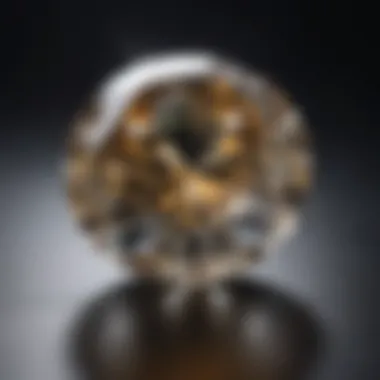
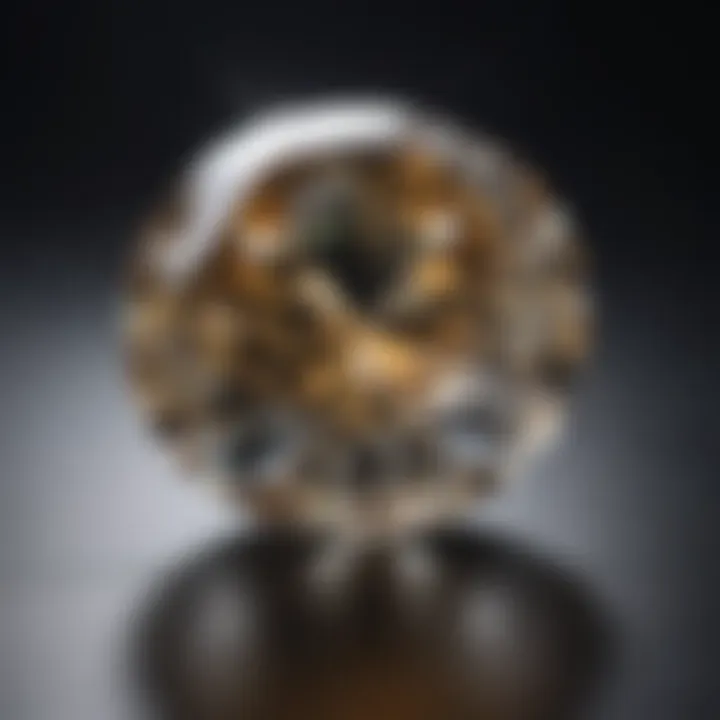
- Maximized Lustre: A diamond with an exemplary cut can reflect more light, creating that captivating sparkle.
- Value Addition: Superior cuts often fetch higher prices in the market.
- Visual Illusion: Cuts can create a perception of size, making smaller diamonds look larger.
However, achieving a perfect cut comes with its challenges—usually requiring skilled craftsmanship, and thus, it reflects in the price.
Color
Color in diamonds ranges from completely colorless to shades that can be warmer, like slightly yellow or brown hues. The most sought-after diamonds exhibit little to no color, as they are seen as a true representation of purity. In this respect, the pricing is heavily influenced by the rarity of colorless diamonds.
Some points about color include:
- Color Grading: The Gemological Institute of America (GIA) uses a scale from D (colorless) to Z (lightly colored) to grade diamonds, with D being the most valuable.
- Popularity: Diamonds that fall within the D to F range are often in high demand and command a premium.
- Unique Characteristics: Diamonds with hues like blue, pink, or green can attract high prices due to rarity, as they fall into the category of fancy colors.
The unique aspect of color is that it directly affects perceived value, with buyers often expecting to pay significantly more for clearer stones.
Clarity
Clarity refers to how clear a diamond is, measured by the presence of internal or external flaws known as inclusions and blemishes. Higher clarity grades indicate fewer imperfections and thus increase the diamond's value. While many diamonds have some level of inclusions, they're often invisible to the naked eye, making clarity a more subtle yet highly influential factor.
In considering clarity:
- Grade Scale: Clarity is graded from Flawless to Included, significantly impacting the price. Flawless diamonds are exceedingly rare and command sky-high premium prices.
- Visual Investment: High clarity ensures that the physical beauty of the diamond is not overshadowed by visible flaws.
- Balance of Cs: Sometimes, purchasers might prioritize other factors, like cut over clarity, depending on where their preferences lie.
Carat
Carat weight is the most straightforward of the Four Cs—it refers to the weight of the diamond. Buyers often associate higher carat weight with more value. However, this can be a double-edged sword. While often desirable, as a diamond's size increases, so do the costs reflect not just weight, but also the rarity of larger diamonds.
Carat weight brings along several considerations:
- Size vs. Price Relationship: The price increases significantly with carat weight, often not in direct proportion but exponentially.
- Visual Impact: Larger carat diamonds are more likely to attract attention, often becoming a focal point in jewelry.
- Comparative Rarity: Finding large, high-quality diamonds can be less common, further pushing prices upwards.
Each of the Four Cs interconnects in ways that can either elevate or diminish a diamond's price. Understanding these factors helps potential buyers make informed decisions that align with their desires and financial capacities.
Market Demand and Availability
The overall market demand for diamonds closely affects their pricing dynamics. Economic conditions, cultural trends, and seasonal events all contribute to whether diamonds are on the higher or lower ends of the price spectrum. For example, during engagement season, prices may peak due to increased demand. Availability also plays a significant part, particularly for specific diamond qualities or sizes. In a market with limited supply of certain diamonds, prices can skyrocket. Thus, astute prospective buyers keep an eye on market conditions to optimize their purchase timing.
Comparison of Carat Diamonds Across Different Markets
When discussing the pricing of diamonds, particularly one as substantial as a 10 carat, it becomes crucial to examine how prices can fluctuate across various markets. The landscape of diamond sales isn't uniform. Instead, it is a patchwork of retail environments, distribution channels, and consumer preferences, all impacting what buyers can expect to pay. Understanding these variances can empower gemstone enthusiasts, collectors, and jewelry designers to make educated decisions when investing in these exquisite gems.
Retail vs. Wholesale Pricing
When you stroll into a jewelry store, the price tag you see for a 10 carat diamond is often a world apart from what you might find at a wholesale distributor. Retail pricing typically encompasses a range of overhead costs, including rent, utilities, and sales commissions. This often leads to a markup that can reach up to 100% or more above the wholesale price.
On the flip side, wholesale pricing is significantly lower. This is because wholesalers deal in larger volumes and operate on thinner margins. They sell directly to retailers or sometimes to consumers who know the right channels to access them. It's like comparing apples and oranges – the quality and specifications remain the same, but the market dynamics lead to drastic price differences. This disparity underscores the importance of buyers knowing where to find their diamonds.
- Advantages of Retail Buying:
- Considerations for Wholesale Purchasing:
- Personalized service and expert advice
- Can inspect the diamond physically
- Wider selection of settings and styles
- Need for expertise to ensure quality
- Limited selection, mainly focused on the stone itself
- Often requires a trade account or connections to access the best deals
Online Stores vs. Brick-and-Mortar Shops
In recent years, the rise of e-commerce has altered the diamond buying experience significantly. The choice between online stores and traditional brick-and-mortar shops presents unique advantages and challenges.
Online stores often boast lower prices due to minimal overhead compared to physical shops. They provide vast selections of diamonds and allow buyers to easily compare prices from various vendors. However, purchasing diamonds online requires a degree of caution. It’s essential to ensure that the retailer follows best practices around certification and provides detailed images or videos of the stones.
On the other hand, brick-and-mortar shops offer tactile experiences. Customers can see the diamond's sparkle in different lighting, hold it, and examine it closely. Here, one can also engage with knowledgeable sales staff who can guide through the labyrinth of diamond features, ultimately making the buying process a personal and perhaps more reassuring experience.
"While the joy of purchasing a diamond may come from visual and tactile engagement, don’t overlook the competitive prices and thorough comparisons that online shopping offers."
Ultimately, whether you choose to buy online or in-store, the key is to conduct diligent research. Each market has its pros and cons, and being aware of these can significantly influence your final decision and ensure you're getting the best bang for your buck.
Cost Variations Based on Diamond Characteristics
When it comes to diamonds, the variations in cost hinge largely on the characteristics intrinsic to the stone itself. Not all diamonds are cut from the same cloth, so to speak. Several elements count toward the price tag attached to a diamond, particularly a 10 carat one, where even minor differences can lead to considerable fluctuations in value. Understanding these cost variations is vital for anyone in the market—be it buyers, sellers, or enthusiasts—providing clarity in a landscape often muddled by myth and misconception.
Natural vs. Lab-Created Diamonds
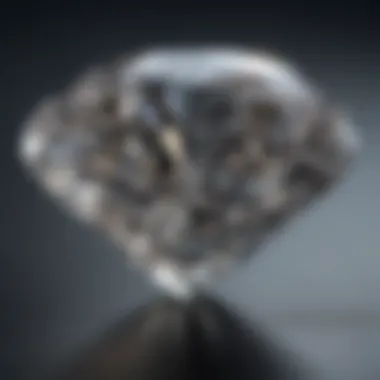

In this day and age, the debate between natural and lab-created diamonds is more prominent than ever. Natural diamonds, formed deep within the Earth over millennia, have long been regarded as the epitome of luxury. Their rarity naturally drives up prices. A 10 carat natural diamond can command prices in the hundreds of thousands to over a million dollars, depending on its quality. The emotional appeal tied to their irreplaceable nature adds an extra layer to their market value.
On the contrary, lab-created diamonds, born from advanced technology, often mimic their natural counterparts in both aesthetic and chemical structure. While these stones typically cost 30 to 50% less than natural ones, they carry some stigma for those who view them as less authentic. Still, for the budget-conscious consumer or individuals aiming for a larger stone without breaking the bank, these diamonds provide an excellent alternative.
"A diamond is a diamond, whether it emerges from the earth or the lab. What matters is the value you attach to it."
Fancy Color vs. Colorless Diamonds
Diamonds can be categorized not only by their clarity and cut but also by their color. Colorless diamonds are traditionally favored, often fetching higher prices, especially when they possess a perfect grade from established gem grading systems like GIA. However, fancy color diamonds, which exhibit hues such as pink, blue, or yellow, can command staggering prices, sometimes exceeding those of their colorless siblings. This astonishment comes from both their rarity and market demand.
For instance, a vivid blue diamond could far outstrip the sale price of a clear diamond of equal carat weight, simply due to its dazzling color and market popularity. Collectors might find themselves drawn to unique colors, perceiving them as investment opportunities. Selling these extraordinary stones requires careful consideration of market trends and the specific sounds of the niche clientele drawn to them.
In summary, diamonds are not just a blank canvas of carats; their origin, color, and the stories that come with them play crucial roles in assessing their true worth. Understanding these distinctions helps create a more informed approach when navigating purchases, ensuring that each choice aligns with both emotional and financial goals.
Geographical Influences on Pricing
The importance of geographical influences on pricing in the diamond market cannot be overstated. The interplay between local economic factors, market demand, and cultural values creates a mosaic of pricing that is both fascinating and complex. Understanding these geographical influences is essential for potential buyers and jewelers alike, as it can greatly affect the selection and pricing of a 10 carat diamond.
- Market Demand: Different areas may have varying demands for diamonds. For instance, cities known for luxury markets, like New York or Dubai, often have inflated prices due to the high volume of affluent clients, while a smaller town might offer lower prices due to less demand.
- Economic Conditions: The economy of a region plays a significant role. In an economy that's prospering, buyers may be more willing to spend larger sums on luxury items. Conversely, during economic downturns, prices might drop as demand decreases.
- Import Tariffs and Local Regulations: Regions with high import tariffs on diamonds can see significant markup in pricing. Understanding these local regulations can provide a clearer picture of the final cost.
Regional Variations in Quality and Pricing
When it comes to regional variations in quality and pricing, there are several layers to consider. Not all sources of diamonds are created equal; the origin can dramatically influence both quality and cost. For instance, diamonds from established markets like South Africa or Botswana may carry a reputation for superior quality and ethics, thus commanding a higher price. Meanwhile, diamonds sourced from areas with less stringent mining regulations may vary in quality and consequently, pricing.
A few notes to ponder:
- Source: Countries like Canada are gaining recognition for their ethically mined diamonds, which can come at a premium due to higher production costs.
- Local Expert Knowledge: Jewelers in major cities often have access to a wider range of diamonds and better resources to assess their quality, which potentially leads to higher prices due to their expertise.
- Access and Convenience: In regions where access to quality diamonds is easier, pricing may be more competitive.
Cultural Perceptions of Diamonds
Cultural perceptions play a noteworthy role in the pricing of diamonds across different regions. The stories and meanings attached to diamonds affect how much buyers are willing to pay and can even dictate the style and type of diamonds in demand. For example, in cultures where diamonds are synonymous with marital success and wealth, the demand and prices can skyrocket.
- Tradition and Symbolism: In some cultures, larger diamonds are not just symbols of wealth but also of prestige and heritage. This leads to a greater value being placed on larger stones, like the coveted 10 carat diamond.
- Changing Norms: Recent trends show a shift in preferences; some younger generations lean towards unique, ethically-sourced stones, leading to a rise in interest for lab-created diamonds or antique pieces.
"Purchasing a diamond is not merely a transaction; it embodies values, traditions, and aspirations that transcend the physical gem itself."
Investment Potential of Diamonds
Understanding the investment potential of diamonds is crucial for anyone considering buying a 10 carat diamond. This gemstone is more than just a piece of jewelry; it's a tangible asset that can appreciate in value over time. Many people view diamonds as a safe haven during economic downturns, as they tend to hold their value better than more volatile investments like stocks or cryptocurrencies.
When reflecting on the worth of diamonds, several factors come into play: their rarity, demand in the marketplace, and the overall economic conditions. Unlike traditional stocks, diamonds don't require constant monitoring of market fluctuations, making them appealing for long-term investors. Well-selected diamonds can act like a hedge against inflation, often increasing in value as the cost of living rises.
However, potential investors should approach carefully. The diamond market can be tricky due to the varying quality and pricing influenced by the Four Cs—cut, color, clarity, and carat weight. Furthermore, trends can shift, affecting desirability and value. In this sense, diamonds require a careful selection process and educated insight into market dynamics.
Additionally, maintaining liquidity might pose a challenge. Unlike stocks or bonds, which can be sold at the click of a button, selling a diamond encompasses a more intricate process; finding the right buyer often takes time and effort.
Understanding Diamonds as an Investment
Investing in diamonds might not be everyone’s cup of tea, but understanding their investment potential is necessary for those looking to diversify their portfolio. Investing is not solely about the money; it’s about passion and knowledge, especially when it comes to diamonds.
- Rarity: A 10 carat diamond is not something you come across every day. The larger the carat weight, the rarer the stone. Thus, a bigger diamond often commands a grater price.
- Quality: The quality of a diamond determined by the Four Cs influences its resale value. High-quality stones in the right settings tend to fetch higher prices.
- Market Trends: Keeping an eye on market trends can guide investment decisions. For instance, the rising popularity of lab-created diamonds has begun to influence prices of natural stones. These trends should be thoroughly researched.
By investing in diamonds, collectors and enthusiasts have the opportunity to own a piece of art that also serves as a store of wealth.
Historical Price Trends
Looking back at historical data can provide valuable insights into the future value of diamonds. Various studies indicate that over the long run, diamonds tend to appreciate in value, barring market shocks or sudden surges in synthetic diamond production.
- Long-term Appreciation: Statistics suggest over the past few decades, the price of natural diamonds increased significantly. For example, between 2000 and 2018, the average price of diamonds rose by approximately 70%.
- Market Disruptions: The diamond market has seen fluctuations due to geopolitical issues, global economics, and changes in consumer preferences. For instance, the introduction of synthetic diamonds in the market has led to a notable impact on pricing dynamics, especially in the lower tier of the market.
- Investment Viability: Historical trends indicate that while diamonds have preserved capital, prospective investors should keep in mind that not all diamonds appreciate similarly. It's wise to focus on stones that are not just beautiful but also have a reliable pedigree and certification.
In wrapping up this section, it’s crucial to understand that while diamonds do offer investment potential, they also come with their share of complexities. Being informed and prudently selecting pieces for investment can yield dividends in the long run.
Ethical Considerations in Diamond Purchasing
When it comes to purchasing a diamond, especially one as significant as a 10 carat, ethical considerations are paramount for many buyers. This section aims to shed light on the implications of diamond sourcing and the broader effects it may have on human rights and the environment. In an era where conscientious consumerism thrives, understanding the journey of a diamond from mine to market can empower individuals to make choices aligned with their values.
One crucial aspect in this discussion is the Kimberley Process, an international certification scheme aimed at preventing the trade of conflict diamonds. Conflict diamonds are extracted in war zones and sold to finance armed conflict against governments, leading to significant human suffering and environmental degradation. While the Kimberley Process has made strides in addressing these issues, it is not without its criticisms. Some argue that it does not cover all scenarios, sometimes allowing diamonds from dubious sources to enter the market. Thus, buyers should be aware of the limitations of this certification.
"Ethical purchasing goes beyond just avoiding conflict diamonds. It includes understanding the full supply chain and its impact on communities and the environment."
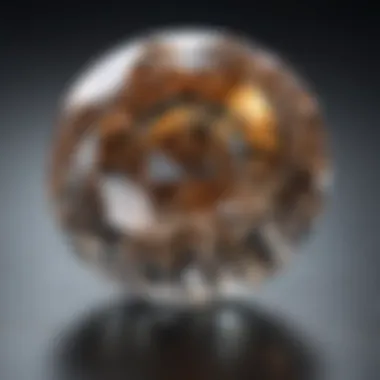
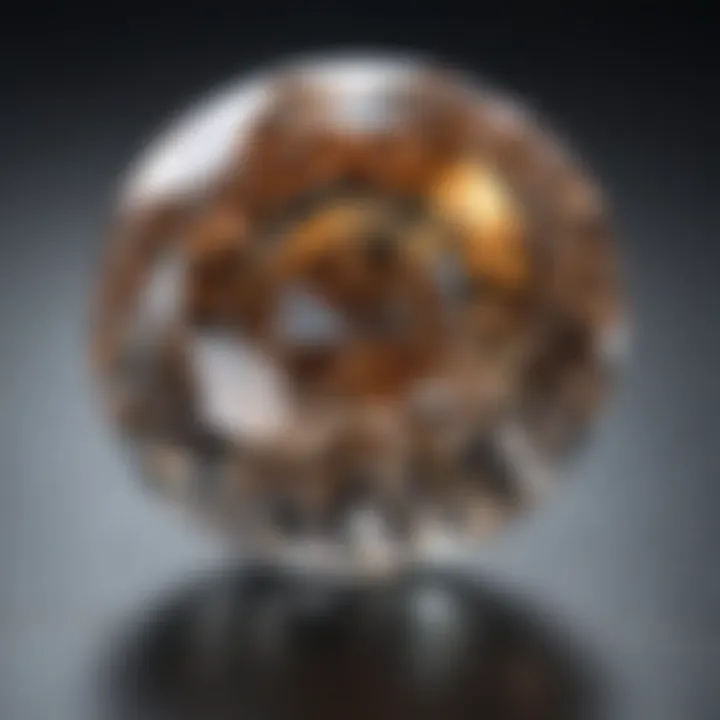
Making informed choices also extends to selecting conflict-free diamonds. Retailers and jewelers often provide documentation or guarantees that certify the ethical sourcing of their diamonds. It is advisable for consumers to seek out sellers who adhere to strict ethical standards. Here are some tips for ensuring that a diamond is conflict-free:
- Ask for certification: Look for certificates that indicate a diamond's origin or that it has been sourced from mines adhering to ethical practices.
- Research the retailer: Investigate the jeweler's policies regarding ethical sourcing. Many reputable ones will be transparent about their practices and their diamond supply chain.
- Consider alternatives: There are lab-created diamonds available that offer a stunning visual appeal with minimal environmental impact. These stones are becoming increasingly popular among those who prioritize sustainability.
By emphasizing ethical considerations, potential buyers help shape the market and encourage retailers to adopt more humane practices. As the conversation around responsible sourcing continues, understanding these parameters enhances not only the value of the diamond but also its worth in the context of responsible consumerism.
Tips for Buying a Carat Diamond
Purchasing a 10 carat diamond isn’t just about choosing a shiny rock. It's a significant investment and demands careful consideration. This section aims to guide prospective buyers through the intricate pathways of making a sound decision. Understanding the essential tips can help navigate the murky waters of diamond buying and emerge with a gem that not only sparkles but also holds its worth over time.
Setting a Budget
Setting a budget might seem straightforward, but when it comes to diamonds, it's like trying to hit a moving target. Prices for a 10 carat diamond can vary wildly, influenced by myriad factors—clarity, color, cut, and even the market trends of the day. It isn’t just about how much you’re willing to spend; it also requires considering future resale value and personal financial situation.
A good starting point is to land on a number that feels comfortable. Here’s how to go about it:
- Determine Your Financial Comfort: Before walking into a store or browsing online, reflect on what you can genuinely afford. Having a clear range can save time and keep your expectations realistic.
- Account for Additional Costs: Beyond the diamond itself, remember to factor in costs for insurance, setting, and potentially prolonged negotiations.
- Research Market Prices: Check credible online platforms, like en.wikipedia.org or britannica.com, to get a sense of the current market price for diamonds of this size. Make notes and be prepared for various pricing strategies.
- Potential for Emotional Value: Sometimes, the most significant aspect of a diamond is the story behind it or the feelings attached to it. Factor this into your budget as these sentimental values often influence purchasing decisions.
By setting a budget beforehand, buyers can filter options that fit their financial ability while avoiding impulse purchases that lead to regret.
Choosing the Right Jeweler
With the budget set, the next pivotal task is picking the right jeweler. When investing in something as grand as a 10 carat diamond, the last thing you want is to engage with someone who doesn't have your best interests at heart.
Here are some important factors to consider:
- Reputation and Reviews: Check reviews on reddit.com or other reputable platforms. A trustworthy jeweler will boast a history of satisfied customers and positive feedback.
- Certifications Matter: Ensure the jeweler provides certification from recognized agencies like the Gemological Institute of America (GIA). This not only confirms the quality of the diamond but also ensures the jeweler is selling you what they say they are.
- Transparency in Sales: Observe their willingness to answer questions about diamonds. They should provide you with detailed information on the diamond’s characteristics without hesitation.
- Personal Connection: Sometimes, it’s about the vibe. A jeweler who understands your needs and respects your budget can make a considerable difference in your purchasing experience.
Dealing with informed and reputable jewelers can alleviate many of the stresses commonly affiliated with buying high-value gemstones.
Remember: The goal isn’t merely to buy a diamond; it’s to invest wisely and make a choice that resonates with both your preferences and your budget.
Future Trends in Diamond Pricing
Understanding the future trends in diamond pricing is crucial for consumers and investors alike. As we advance into an era where synthetic diamonds are gaining traction and consumer preferences are evolving, being aware of these changes can inform smart purchasing decisions. This section dives deep into the nuances of how these factors are reshaping the diamond market.
The Impact of Synthetic Diamonds
Synthetic diamonds, also known as lab-created diamonds, have revolutionized the industry. They’re not merely second-rate imitations; these gems are chemically and physically identical to their natural counterparts. One striking difference, however, lies in their pricing. Generally, synthetic stones can be priced 30-40% lower than similar natural diamonds, reflecting the lower cost of production and the reduced rarity factor.
The rise of synthetic diamonds poses some interesting questions. Are they diluting the market value of natural diamonds? In some quarters, the answer is yes. As consumers seek affordability, the demand for natural stones is somewhat tempered. However, it’s essential to note that natural diamonds carry an intrinsic value tied to their geological history and authenticity. Many buyers remain willing to pay a premium for the allure and status that natural stones signify.
Moreover, there lies a growing awareness around the environmental implications of diamond mining. As synthetic diamonds offer a more eco-friendly alternative, they attract eco-conscious consumers. Additionally, the narrative around ethical diamond sourcing propels further interest in lab-created options. Thus, while synthetic diamonds may challenge traditional pricing models, they also serve to enhance consumer education about ethical options and sustainability.
"The advent of synthetic diamonds is not just a market shift; it's a cultural transformation that affects perceptions of value and luxury within jewelry."
Emerging Markets and Demands
Emerging markets are pivotal in reshaping the diamond industry landscape. Countries like India and China have demonstrated an insatiable appetite for luxury goods, fuelling demand for diamonds. As standards of living rise in these regions, a new wave of consumers is entering the market, eager to invest in diamond jewelry as a status symbol.
On the flip side, there’s an ever-growing acceptance of alternative investments, including synthetic diamonds and colored diamonds, particularly among younger buyers who are more attuned to value over tradition. This demographic often prioritizes personal taste and ethical considerations, which could spell trouble for the natural diamond market if it doesn’t adapt.
The growing trend of online purchasing also alters the landscape, allowing consumers from emerging markets better access to diamond products. Specialized platforms are catering to these new buyer segments by providing detailed information, virtual try-ons, and transparent pricing. As these trends converge, the demand fluctuations could lead to more variable diamond pricing, revealing both opportunities and challenges for investors and collectors.
In summary, keeping an eye on these emerging markets and evolving consumer preferences can provide insights into future pricing trends. The dynamics of supply and demand, shaped by a blend of traditional values and modern considerations, will undoubtedly keep the diamond industry on its toes as it navigates through this changing terrain.
End: The Complex Landscape of Diamond Valuation
In understanding the valuation of a 10 carat diamond, one must navigate a landscape that is far from straightforward. This article has shed light on various crucial factors that contribute to the pricing of such a noteworthy gemstone. Grasping these elements provides potential buyers and collectors with the necessary insight to make informed decisions in a market rife with both opportunities and challenges.
The cost of a diamond is not merely a numeric figure; it is the outcome of its unique characteristics, market dynamics, and ethical considerations surrounding its procurement. The Four Cs—cut, color, clarity, and carat weight—serve as foundational elements in establishing a diamond's value. However, the interplay of these qualities against market demand and availability adds layers of complexity to the evaluation process, making it essential for buyers to educate themselves thoroughly prior to making a purchase.
Summarizing Key Factors
- The Four Cs: Since many might think that only the carat weight matters, it's important to clarify that cut, color, and clarity are equally significant. A well-cut diamond with superior clarity can often outshine larger stones with lower quality characteristics.
- Market Dynamics: Fluctuations in market demand can drastically influence pricing. Multiple external factors, such as economic stability and consumer trends, play crucial roles here. When people are keen to spend, diamond prices tend to soar.
- Ethical Considerations: The rising awareness of the ethical implications related to diamond mining cannot be overstated. Many buyers now prioritize conflict-free diamonds, impacting their pricing and availability.
- Geographical Factors: Where you buy a diamond can also sway its price. Notably, retail pricing often differs from wholesale, and certain regions may display a higher mark-up due to local demand.
Encouraging Informed Purchases
When it comes to acquiring a 10 carat diamond, informed buyers are the most empowered buyers. By arming oneself with knowledge from this article, individuals can take a measured approach to their purchase.
- Research: Before diving into a purchase, it's wise to extensively research diamonds and their grading system. Familiarize yourself with the Four Cs in detail, as they are key in evaluating potential purchases.
- Set Budgets: Knowing your financial parameters will help avoid overspending or compromising quality. Stick to your budget, but be prepared to adjust based on the diamond's characteristics.
- Choose Credible Sources: Only trust reputable jewelers or online platforms that are known for their transparency and ethical practices. Certifications from recognized grading entities provide reassurance about the stone's quality and authenticity.
- Ask Questions: Don’t hesitate to inquire about the diamond’s journey. Understanding where and how a diamond was sourced adds another layer to its valuation.
"Knowledge is power," or so the saying goes. In this case, it couldn't ring more true. When you walk into a jeweler's shop well-informed, you're no longer at the mercy of sales tactics; rather, you’re in control of your purchase, ensuring that it aligns with both your aspirations and your ethical stance.
In summary, the landscape of 10 carat diamond valuation is intricate but navigable with the right approach. Delving into the details explored within this article not only enhances one's understanding but also encourages thoughtful, ethical choices when investing in such an exquisite gemstone.



